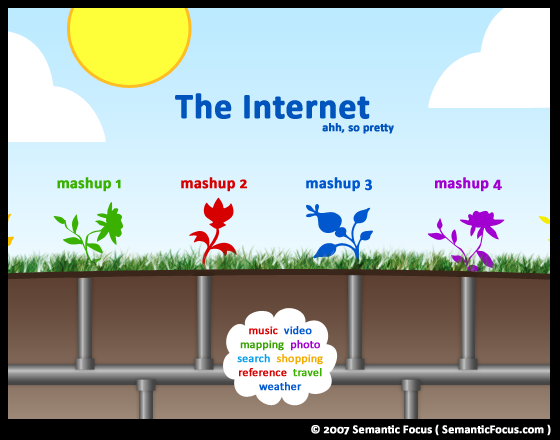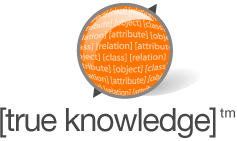 In Part 2 of this series we reviewed Unicode, URI, and XML - three foundational technologies that permeate the existing Web and that are especially relevant to the emerging Semantic Web. We will put all three to use as we take our next step up the Semantic Web layer cake in a review of the Resource Description Framework (RDF). At the same time, we will be taking the visual RDF/OWL editor, Altova SemanticWorks, for a test drive. Since I will be using this tool for the very first time, you can expect an honest review that is rich with screenshots. If you do not already have the software, you may wish to download the trial version now so you can follow along.
In Part 2 of this series we reviewed Unicode, URI, and XML - three foundational technologies that permeate the existing Web and that are especially relevant to the emerging Semantic Web. We will put all three to use as we take our next step up the Semantic Web layer cake in a review of the Resource Description Framework (RDF). At the same time, we will be taking the visual RDF/OWL editor, Altova SemanticWorks, for a test drive. Since I will be using this tool for the very first time, you can expect an honest review that is rich with screenshots. If you do not already have the software, you may wish to download the trial version now so you can follow along.
14 results for web object oriented
Metadata or Hyperdata, Link or Thread, What is a Web of Data?
Published 16 years ago by Yihong Ding
After the last post about "web of agents", I received a few questions about the "web of data." A few readers mistook my argument to be opposite of a web of data. Don't get me wrong, I have never been opposed to the presentation of a "web of data." I only emphasize that the web-of-data presentation is short of describing the human-web relationship in the Semantic Web. To encourage the engagement of more ordinary people to the grand vision of the Semantic Web, we need a more user-oriented presentation, i.e. a web of agents.
Continue reading Metadata or Hyperdata, Link or Thread, What is a Web of Data?
ARC - RDF and SPARQL for PHP developers
Published 17 years ago by James Simmons
 ARC is a lightweight, SPARQL-enabled RDF system for mainstream Web projects. It is written in PHP and has been optimized for shared (or performance- or privilege-limited) Web environments. ARC facilitates the integration of RDF and SPARQL into PHP/MySQL frameworks.
ARC is a lightweight, SPARQL-enabled RDF system for mainstream Web projects. It is written in PHP and has been optimized for shared (or performance- or privilege-limited) Web environments. ARC facilitates the integration of RDF and SPARQL into PHP/MySQL frameworks.
ARC is a very well documented project, which I think is important for its success. Their documentation is clear, concise, and provides plenty of inline sample code to examine as you read and learn.
The Object Oriented Web - Part 1 - Backlinks
Published 16 years ago by Manuel Vila
 The more we use the Internet, the more we realize the necessity of finding new solutions to better organize the growing mass of information. Today we actually have a certain number of tools to add meaning to the information that we drop all over the Web. Adding a comprehensible meaning to computers, allowing them to help us better organize things. That's the big idea behind the Semantic Web, an idea which appears more and more obvious to us everyday. In this field, we already have many advanced technologies, starting with those offered by the W3C itself: XML, RDF, OWL, etc.
The more we use the Internet, the more we realize the necessity of finding new solutions to better organize the growing mass of information. Today we actually have a certain number of tools to add meaning to the information that we drop all over the Web. Adding a comprehensible meaning to computers, allowing them to help us better organize things. That's the big idea behind the Semantic Web, an idea which appears more and more obvious to us everyday. In this field, we already have many advanced technologies, starting with those offered by the W3C itself: XML, RDF, OWL, etc.
Continue reading The Object Oriented Web - Part 1 - Backlinks
The Object Oriented Web - Part 2 - Datahubs
Published 16 years ago by Manuel Vila
 To begin with, there is a very simple idea: Websites should themselves indicate their changes to the search engines. I've already touched upon the subject in the previous part of this series, right now search engines have a reversed approach which consists of crawling the Web constantly looking for the slightest modification. Don't you think it's silly? Think about the number of Web pages to visit, imagine the cost to get the lowest frequency between each visit. Consequently, it seems difficult to consider the development of new search engines today. Nevertheless, the advent of the Semantic Web should lead to their multiplication, in a vertical way, while search engines are getting specialized more and more in specific fields.
To begin with, there is a very simple idea: Websites should themselves indicate their changes to the search engines. I've already touched upon the subject in the previous part of this series, right now search engines have a reversed approach which consists of crawling the Web constantly looking for the slightest modification. Don't you think it's silly? Think about the number of Web pages to visit, imagine the cost to get the lowest frequency between each visit. Consequently, it seems difficult to consider the development of new search engines today. Nevertheless, the advent of the Semantic Web should lead to their multiplication, in a vertical way, while search engines are getting specialized more and more in specific fields.
Continue reading The Object Oriented Web - Part 2 - Datahubs
The Object Oriented Web - Part 3 - Social Networks
Published 16 years ago by Manuel Vila
 Once again, the main idea behind the social network comes from a reversal process. We're dealing with an approach focused on the people (user-centric) and not on the applications allowing us to produce various data (text with blogs, pictures on Flickr, videos on YouTube, etc.). Rather than indicate to our contacts the numerous RSS feeds representing our "digital life", we are going to point at a unique address (our OpenID) whereby they will have access to any shared data. Even better, they will be able to add us in their contact list in order to automatically receive our new data (our "lifestreams"). To draw a parallel between an existing tool, adding an RSS feed to an aggregator like Google Reader comes down to adding a contact in our social network. But there is a major difference because this new approach simplifies things a lot while introducing many new fascinating possibilities.
Once again, the main idea behind the social network comes from a reversal process. We're dealing with an approach focused on the people (user-centric) and not on the applications allowing us to produce various data (text with blogs, pictures on Flickr, videos on YouTube, etc.). Rather than indicate to our contacts the numerous RSS feeds representing our "digital life", we are going to point at a unique address (our OpenID) whereby they will have access to any shared data. Even better, they will be able to add us in their contact list in order to automatically receive our new data (our "lifestreams"). To draw a parallel between an existing tool, adding an RSS feed to an aggregator like Google Reader comes down to adding a contact in our social network. But there is a major difference because this new approach simplifies things a lot while introducing many new fascinating possibilities.
Continue reading The Object Oriented Web - Part 3 - Social Networks
Mashups: Opportunity, Innovation, and Money
Published 17 years ago by James Simmons
A mashup is a hybrid Web application that combines complementary elements from two or more sources to create one integrated experience. Content used in mashups is generally sourced from a third party via an API or from Web feeds (e.g. RSS or Atom). Basically, the point is to take multiple data sources or Web services and turn them into something useful. The idea of combining Web services is not a new one, but it has gained immense traction in recent times and will likely continue to grow in popularity. In this entry I will be discussing both the promising future mashups offer and also potential pitfalls.

Continue reading Mashups: Opportunity, Innovation, and Money
Some Truth about the Semantic Web
Published 16 years ago by Yihong Ding
More and more people are starting to discuss the Semantic Web, but few truly understand how it is different from the traditional World Wide Web. Though the Semantic Web will be realized as a layer upon the current Web, some of their basic philosophies are going to be updated significantly. This post tries to list some truth about the Semantic Web that is critical but often overlooked.
True Knowledge: The Natural Language Question Answering Wikipedia for Facts
Published 16 years ago by James Simmons
 True Knowledge is a natural language search engine and question answering site, but to leave it at that would not do the site justice. What makes it stand out from similar sounding services like Powerset and Freebase? True Knowledge tackles natural language search and question answering (much like Powerset and Hakia), and it also maintains a knowledge base of facts about the world (similar to DBpedia and Freebase). However, what makes True Knowledge stand out is that they've combined these features and encourage their userbase to contribute facts and add new knowledge.
True Knowledge is a natural language search engine and question answering site, but to leave it at that would not do the site justice. What makes it stand out from similar sounding services like Powerset and Freebase? True Knowledge tackles natural language search and question answering (much like Powerset and Hakia), and it also maintains a knowledge base of facts about the world (similar to DBpedia and Freebase). However, what makes True Knowledge stand out is that they've combined these features and encourage their userbase to contribute facts and add new knowledge.
Continue reading True Knowledge: The Natural Language Question Answering Wikipedia for Facts
The Pragmatic Semantic Web and Web Evolution
Published 16 years ago by James Simmons
Lately we've been talking a bit about Web evolution, and right now we're tossing back and forth the idea of grassroots vs. ivory towers. In that entry I described the belief Yihong and I have that the grassroots (developers) will need to take the reins so to speak from the ivory towers (W3C, purely academic research, etc) in order to ensure its adoption.
Continue reading The Pragmatic Semantic Web and Web Evolution
Recent searches
semantic, semantic web search, microsoft semantic web, semantic web blog, semantic focus, semantic web search engine, semantic web problems, semantic cms, semantic web search engines, semantic web, semantic web blogs, camp semantic, semantic web layer cake, natural language processing blog, semantic web microsoft, sparql php, semantic blog, natural language search, true knowledge, eswc 2009, object oriented web, protege tutorial video, rdf tags, introduction to semantic web, php sparql, microsoft rdf, microformats rdf, semantic web conference 2008, owl semantic web, problems with semantic web, rdf vs microformats, cody burleson, protege tutorial, rdf search engine, microformats vs rdf, rdf microformats, semantic web tutorial, semantic web conference 2009, rdf blog, eswc 2008, graphd, rdf microformat, semantic web rdf, blog semantic web, semantic web conference, european semantic web conference 2009, dbpedia freebase, web service life cycle, semanticfocus, python sparql, problems in semantic web, swoogle, curse of knowledge, semantic web introduction, semantic web issues, statistical search, semantic web layers, semantic web vision, twine blog, semantic web podcasts, owl videos, rdf tagging, semantic web natural language processing, arc rdf, falcons search engine, protege 4 tutorial, web videos, european semantic web conference 2008, semantic search engine, semantic web community, semantic web tutorials, semantic natural language processing, semantic web problem, semantic web videos, microformat rdf, natural language processing semantic web, web search engines, open calais, problems with the semantic web, rdf tag, semantic web cake, web thread, tower of babel, bin laden, rdf microsoft, semantic web technology stack, natural language processing blogs, natural language question answering, rdf owl, protege screencast, semantic web logo, problems of semantic web, information extraction blog, microformat vs rdf, protege video tutorial, domain knowledge, james simmons, seesaw effect, semantic search, semantic web references, the curse of knowledge, web 3.0 ideas, web semantic, blog semantic, cms tags, question answering, semantic web games, semantic web technology, aditya thatte, rdf video, spanish semantics, web evolution, data storage in oracle, different from, freebase rdf, microsoft and semantic web, problems semantic web, rdf vs microformat, web search engine, what is true knowledge, freebase dbpedia, jamie lewis blog, question answering wikipedia, semantics, web service ontology, zitgist, freebase linked data, introduction to semantic web vision and technologies, ontology blog, owl introduction, protege semantic, selfishness, semantic update, semantic web protege, focus semantics, freebase vs dbpedia, microformats and rdf, microformats vs, microformats vs semantic web, owl tags, protege semantic web, search engine semantic web, semantic web owl, altova tutorial, backlinks blog, calais initiative, eswc 2008 semantic, protege, semantic web microformats, semantic web research topics, semantic web technologies, arc semantic, natural language semantic web, oracle semantic web, owl semantic, problem with semantic web, rdf, semantic web layer, semantic web tags, service ontology, sparql python, vertical search engines, web blogs, blog rdf, cms semantic, dbpedia vs freebase, hyperdata, natural language processing semantics, ping the semantic web, python semantic web, rdf and microformats, semantic search engines, semantic search example, semantic web services, web object oriented, wikipedia question, wordpress semantic web, information extraction, international semantic web conference 2009, list of vertical search engines, microformats, microformats versus rdf, natural language processing, natural language processing wikipedia, object oriented web page, semantic conference 2008, semantic conference 2009, semantic web conferences 2008, semantic web conferences 2009, semantic web feed, semantic web video, social semantic web, w3c logo, web introductions, webblogs, evolution of semantic web, iri semantic web, issues in semantic web, language question, natural language question answering system, on whose vision is the semantic web concept based, oracle data storage, protege 4.0 tutorial, protege ontology, rdf versus microformats, search engines, search semantic web, semantic data storage, semantic web reference, service, web 3.0 opportunities, web services life cycle, aperture semantic, backlink blog, blog semantics, falcons semantic, hl, introduction of semantic web, leave a comment, legs blog, list of blogs, microsoft semantic web, natural language processing semantic, problem of semantic web, problem semantic web, protege tutorials, rdf blogs, rdf review, semantic web 101, semantic web conferences, semantic web natural language, semantic web podcast, semantic web searches, semantics is, service life cycle, service ontologies, vertical search engines list, web conference 2008, wikipedia natural language processing, arc semantic web, blog natural language processing, european semantic web 2008, foaf search, international semantic web conference, international semantic web conference 2008, introduction to semantic, iswc 2008, life cycle of web services, metadata extraction and tagging service, microformats tags, microsoft sparql, object oriented web pages, owl vs rdf, semantic news aggregator, semantic web 2009, semantic web algorithm, semantic web evolution, semantic web game, semantic web layer cake 2008, semantic web service, semantic web sites, service modeling, spanish semantic, sparql in php, tassilo pellegrini, the nature of selfishness, the semantic web is not a separate web but an extension, tutorial protege, camps semantics, eswc 2008 conference, eswc 2008 semantic web, falcons semantic web search engine, freebase, lowell vizenor, metadata extraction, natural language question, nature of selfishness, object oriented web site, oracle semantic store, owl rdf, pagead2.googlesyndication.com, problems of the semantic web, protege 4, rdf vs. microformats, search engines semantic web, semantic logo, semantic markup tags, semantic web searching, semantic web tools, spanish language semantics, starting a revolution, swoogle.com, tag rdf, the semantic web vision, web service lifecycle, wikipedia question answering, arc php, arc rdf php, blogs semantic web, dbpedia, focus, folktologies, microformats vs. rdf, mining tags, ontology, open calais python, podcast semantic web, problem in semantic web, protege introduction, rdf semantic web, search engine for semantic web, selfishness of mankind, semantic problems, semantic updates, semantic web algorithms, semantic web and search engines, semantic web feeds, semantic web part 4, semantic web vs web 2.0, service lifecycle, stochastic search, storage in oracle, using protege, weaving thread, web 3.0 blog, web technology topics, webservice lifecycle, zeitguiest, blog information extraction, blogs on semantic web, camp semantic, conference semantic web 2008, cross pollination wikipedia, eswc conference 2008, eswc tenerife, ftp p2p, information extraction open source, introduction semantic web

Recently Commented Blog Entries